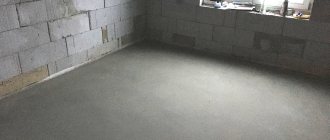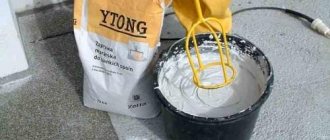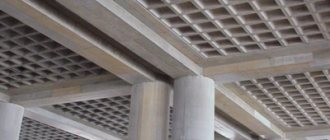During the construction process, various types of concrete are used, which differ in strength, specific gravity and other characteristics.
Among the building materials popular nowadays, it is worth highlighting sand concrete.
Mixtures of this type are easy to both produce and use, and in both cases they are economically beneficial.
According to the classification of the state standard GOST 7473-94 “Concrete mixtures. Technical conditions", sand concrete belongs to fine-grained concrete mixtures (FCM), and according to its intended purpose - to structural concrete and has the characteristics indicated in the tabular data.
In accordance with GOST 7473-94 “Concrete mixtures. Technical specifications”, according to the degree of preparation of the mixture, are divided into the following types:
- ready-to-eat (RBG);
- dry mixes (DSM).
Based on workability, mixtures are divided into groups:
- super-hard (SZh);
- hard (F);
- movable (P).
Concrete mixtures are classified as follows:
- concrete mixtures of lightweight concrete (LBC),
- concrete mixtures of fine-grained concrete (BSM),
- concrete mixtures of heavy concrete (BCT).
Important!
The marking of a concrete mixture consists of an abbreviated designation of the mixture by readiness, type and class of concrete by strength, grade by workability, frost resistance, water resistance, medium density (for lightweight concrete) and the designation of the standard.
For example, BSG V25 P1 F200 W4 GOST 7473-94 is deciphered as follows:
- BGS – ready-mixed concrete mixture of heavy concrete;
- B25 – compressive strength class (in MPa);
- P1 – grade for workability;
- F200 – frost resistance grade;
- W4 – waterproof grade.
Scope of application of sand concrete
Fine-grained concrete is needed in various types of construction and repair work.
The building regulations define the following scope of application:
- sealing cracks and holes in floors and walls;
- the use of sand concrete for screed, including slope-forming screed, is encouraged;
- implementation of masonry;
- pouring concrete, sand-cement bases;
- leveling and filling of floors, including heated floors;
- arrangement of foundations and foundations;
- monolithization of various concrete structures;
- creation of staircase structures;
- construction of elements of the local area, pedestrian paths, etc.
For any type of concrete work, adding a plasticizer allows you to reduce the amount of water in the concrete mixture, increase the workability of concrete and the strength of the finished product.
Important!
The addition of fiberglass reduces the risk of cracks in concrete.
Application in construction and repair work
Sand concrete (BSM) must have a certain strength, which should be taken into account when carrying out work:
- Sand concrete BSM V7.5 P2 F200 W4 GOST 7473-94 (old marking M100). Most often the mixture is used for plastering work. The material does not have good compressive strength (98-100 kg/cm²) and water resistance W4. The composition includes river sand of fraction 0.8-1.2 mm.
- Sand concrete BSM V710 P2 F200 W4 GOST 7473-94 (old marking M150). Suitable for repairing facades and plastering. Often used for pouring screed and brickwork. The compressive strength of the finished coating is 161-150 kg/cm². The composition includes river and quartz sand 0.8-2.0 mm. The material is lightweight and reduces costs. It can be pumped to a height of up to 52 m using a concrete pump.
- Sand concrete BSM V15 P2 F200 W4 GOST 7473-94 (old marking M200). Can be used for arranging screeds for heated floors and other interior work. The composition includes fine-grained river and quartz sand. The finished coating is resistant to deformation and has a compressive strength of 196-200 kg/cm².
- Sand concrete BSM V20 P2 F200 W4 GOST 7473-94 (old marking M250). The material is characterized by durability and high strength (250-262 kg/cm²) and is used in the construction of various enclosing and load-bearing structures, including floors.
- Sand concrete BSM V25 P2 F200 W4 GOST 7473-94 (old marking M300). The mixture is used for the construction of various high-strength concrete structures, the production of expanded clay, pouring floors, etc. This is a universal brand. Such partitions and walls can be easily plastered and tiled. In addition, the practice of using such sand concrete in monolithic construction has fully justified itself.
- Sand concrete BSM V35 P2 F200 W4 GOST 7473-94 (old marking M450) is rarely used in private housing construction; it is applicable when carrying out work on civil and industrial construction sites.
Application for floors and foundation slabs
When conducting low-rise construction or it is impossible to make or order a small volume of heavy concrete, sand concrete can be a successful alternative solution. For the construction of foundations, a mixture with increased characteristics of strength, density and frost resistance is used. To carry out the work, it is advisable to use a material not lower than BSM V25 P2 F200 W4 GOST 7473-94 (old marking M300).
The ready-made solution is also suitable for arranging:
- monolithic strip foundations;
- prefabricated and block structures;
- prefabricated monolithic (mixed) bases.
Technical features by PB brands
The following table shows the characteristics of PB brands:
| Brand | Strength, kg/cm² | Application | Features of the composition |
| M50, M100 | 50, 100 | Sealing seams and cracks. | Minimal amount of cement, no lime. |
| M150 | 150 | Masonry and plaster mortar. | Presence of modified additives. |
| M200 | 200 | Screed for heated floors | The filler is a large fraction of quartz sand. |
| M300 | 300 | Pouring formwork for reinforced concrete structures and foundations. Screeding floors of industrial premises. | Adding plasticizers to increase strength. |
| M400, M500 | 400, 500 | Construction of monolithic reinforced concrete structures in multi-storey buildings. | High Portland cement content. |
Types of sand concrete
Depending on the filler used, sand concrete is divided into three types:
- fine-grained (grain size for the largest particle is up to 1.2 mm);
- medium fraction (grain size – up to 2.5 mm);
- coarse-grained (grain size from 3 to 4 mm).
Important!
The finer the aggregate, the more plastic the concrete solution, it is easier to lay, filling the form without voids, allows you to get a perfectly flat surface, but, on the other hand, the more susceptible it is to shrinkage, and its strength is also lower than that of concrete with coarse filler.
Coarse sand concrete is used for pouring thick screeds (from 20 cm), foundations, plinths, and partitions.
Medium-fraction - for screeds in apartments, heated floors, paving slabs and paving stones.
Fine-grained types are suitable for pouring thin screeds and making products with a smooth surface.
Areas of use of building materials
Sand concrete mixtures of various brands are used in the construction industry to solve various problems:
- performing horizontal and inclined screeds;
- sealing cracks, cavities in walls and on floor surfaces;
- masonry walls made of various materials;
- embedment of reinforced concrete structures;
- concreting cement-sand bases;
Material is used at all stages, from the construction of foundations to interior finishing work
- leveling the floor surface;
- construction of building foundations;
- manufacturing of reinforced concrete products;
- landscaping of the garden area;
- production of decorative tiles for walkways.
Thanks to its expanded range of uses, sand concrete is quickly gaining popularity.
Composition of sand concrete
The exact dosage of all ingredients is selected experimentally and depends on the quality of raw materials and sand concrete production technology (equipment for preparation, pumping and laying). Each one is rarely shared: it is considered a commercial success and is kept secret.
Important!
Concrete compositions are selected in enterprise laboratories in accordance with GOST 27006-86 “Concrete. Rules for selecting the composition” take into account the characteristics of the starting materials and the required qualities of concrete. Formulations should be tested and adjusted if necessary.
Portland cement based on clinker and gypsum, limestone and sand aggregate are used as a binding component.
For example, to prepare sand concrete BSM V25 P2 F200 W4 GOST 7473-94 (old marking M300), grade 42.5 cement is mixed with sand in a ratio of 1:3. 10-15% of the total mass are additives for producing concrete with certain properties: plasticizers, fiberglass, anti-frost and water-repellent additives.
Recommendations
Dry sand concrete mixtures can solve a wide range of problems. Having mastered the recipe and following the technology, it is not difficult to prepare sand concrete yourself.
When planning to build your own home, choose the material responsibly. Using autoclaved aerated concrete blocks, understand what aerated concrete is, and also find out what is the difference between aerated concrete and gas silicate. When choosing foam blocks, analyze the pros and cons of foam concrete. If you want to ensure the stability of the structure, find out whether an armored belt is needed for aerated concrete. On the pages of the site it is easy to find answers to these and other questions.
How to choose the best sand concrete
The quality of sand concrete products directly depends on the quality of the material. Strength is determined by the brand of Portland cement, and the amount of shrinkage is determined by the sand fraction.
Here are some general selection rules:
- Choose mixtures from a trusted manufacturer.
- Pay attention to the date of manufacture. Sand concrete contains cement, the properties of which weaken with each month of storage.
- Assess the mixture visually. High-quality sand concrete can pick up moisture from the air and form lumps; poor quality, with low cement content, will crumble.
- If you are not sure about sand concrete, buy some and do a test batch.
Which is better?
The main components of any mixture are Portland cement, sand and special plasticizers. The strength of sand concrete depends on the grade of Portland cement, and the shrinkage parameters depend on the size of the sand fraction. The composition of the M300 brand is considered a universal material, however, in practice it is permissible to use low-grade solutions, which depends on the tasks assigned to the builder.
The best mixture is the one purchased from a good manufacturer or carefully prepared with your own hands and used strictly for its intended purpose. The choice of material should be based on the purpose and operating conditions of the coating being poured.
A mixture that is suitable for use has the following characteristics: it is a dense, viscous, homogeneous and plastic mass that must be used within two to three hours. Strength optimal for other work is achieved on the seventh day, final strength – on the 28th day.
How to prepare concrete solution
Due to the fact that the dry mixture contains all the necessary components, and the instructions indicate in what proportion to add water, using sand concrete is easy and convenient. The materials are loaded into a running mixer simultaneously and mixed for 1-2 minutes. In private construction, when using a mixer, the solution is mixed until smooth.
In winter, the solution can be mixed with warm water. In this case, water at a temperature not exceeding 70°C is used.
For winter work, it is necessary to use complex antifreeze additives, which accelerate the strength gain of concrete and prevent the destruction of concrete structures.
Technical features
Among the technical features of the material, it is customary to highlight the following aspects:
- To prepare the solution, 1 kg of dry mixture requires 0.15 liters of water without impurities.
- If you need to make a floor screed up to 10 mm thick, 20 kg of mixture will be required per 1 m².
- The approximate preparation time for the mixture is 2 hours.
- Waterproof up to 99%.
- The screed sets within 3 hours.
- You can move on the floor only after 5 days from the moment of pouring.
- Within a month after pouring, the material begins to achieve the highest technical characteristics.
Attention!
It is recommended to familiarize yourself with the standards specified in GOST. They are presented in the table below.
How to calculate sand concrete consumption
An important question: how much materials should I purchase so that it will be enough to complete the required volume of work?
Manufacturers indicate on the packaging how much sand concrete is required to fill 1 m2 of screed 1 cm thick. Usually this is 22-24 kilograms.
One cube of concrete can be obtained from 2200-2400 kilograms of the mixture BSM V25 P2 F200 W4 GOST 7473-94 (old marking M300).
What to do if the floor has level differences?
In this case, several measurements of the thickness of the screed are made, the arithmetic average is calculated and used to find the volume of the screed. Another option is to divide the screed into segments in accordance with differences in thickness and calculate the volume for each segment separately.
For more accurate calculations, you can make a test casting. After mixing a small amount of solution, it is poured into a liter plastic bottle. Knowing how much dry mixture was used to produce a 1-liter casting, you can multiply this number by 1000 and find out how much sand concrete is required to produce one cubic meter of concrete. It remains to find out how much concrete is required and calculate the required amount of dry mixture.
When installing heated floors, a special plasticizing and compacting additive is indispensable, with which it becomes easier to level the floor and obtain a perfectly flat, smooth surface.
Cost, packaging and storage conditions
An approximate idea of the cost of sand concrete can be obtained by comparing M300 grade materials from various manufacturers. They are very popular :
- “Stone Flower” - price 40 kg/127 rubles;
- “Rusean” - 40 kg/248 rubles;
- Deluxe – 50 kg/271 RUR;
- Axton sand concrete 30 kg/129 rub.
Indoors, containers with sand concrete should be stored on pallets
The material is sold in factory packaging (the standard is sand concrete in four-layer paper bags). Before purchasing, it is recommended to ensure that the product has all the relevant documents.
For sand concrete, the certificate of conformity confirms that it meets the requirements of GOST (“Concrete mixtures. Technical conditions”). Transportation and storage of bags must be carried out under conditions that ensure the integrity of the packaging and protection from moisture penetration.
Dry sand concrete mixture is a rational solution to many construction problems, due to the high versatility of the mixture.
Sand concrete and its use for floor screed are described in the video:
Components
And yet, what is sand concrete? Manufacturers strive to use the maximum number of innovative solutions and new products in the field of construction. Compliance with proportions also plays an important role. If we ignore these factors, the quality of the material will inevitably deteriorate and, as a result, we will not get the desired result. In addition, if the proportions do not comply with GOST, then the mixture itself becomes susceptible to ambient temperature and begins to let water through.
As a rule, sand concrete is a dry mixture, but sometimes you can find ready-made prepackaged blocks.
The key component of the mixture is cement. Today you can find a variety of types, but if you want your structure to last for a long time, then you should opt for Portland cement. The components of the latter are gypsum and clinker. The first step is to crumble the clinker, and then gradually mix it with gypsum. The result is a highly reliable material with excellent characteristics.
Do not forget that sand concrete is a mixture of Portland cement and sand. The latter can often be coarse or fine-grained, and it is mined from river beds. Some manufacturers also add various minerals to improve the quality of the mixture. These are all kinds of anti-corrosion elements, plasticizers, granite chips, etc.
Most often, sand concrete is a dry mixture, but you can also find ready-made mixture solutions
Turning to GOST, we will see that sand concrete can be divided into three types:
- A material with a fine fraction, which has found its use for plastering, sealing joints and is famous for its high strength.
- Material with a medium fraction (dimensions 2-2.2 mm) is used for screeding floors, making curbs and paving slabs
- Material with a coarse fraction is used for pouring foundations, where the strength and durability of the structure is important.
Classification into such groups is determined by production conditions and occurs using special devices, the so-called. vibration installations, grids and other devices.
Having analyzed the factors described above and based on the approved GOST, we recommend using sand concrete as a building material for internal and external work. You will certainly be surprised by the impeccable quality of the mixture. At the same time, it will be possible to save time and money, which is important in the current conditions. We hope that now you can answer the question: “What is sand concrete?”











